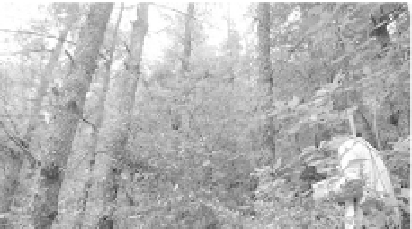Environmental Engineering Reference
In-Depth Information
(a)
(b)
Fig. 11.74
(a) 20 years after planting of
Pinus yunnanensis
the forest had three layers with 12 shrub species and 22 herb
species; (b) In the canopy habitat of 20 years after planting
Leucaena leucocephala
forest there were only 1 shrub
species and 4 herb species (See color figure at the end of this topic)
The results indicate that different planted species have very different effects on soil erosion control and
understory floral communities. Because complex floral communities support complex faunal communities
the wood species used for a watershed reforestation affect the whole terrestrial ecosystem, which in turn
affects the aquatic ecosystem. According to the vegetation-erosion dynamics (see section 2.3.2) the
Xiaojiang River basin may develop into a forest with a certain capacity for self-restoration. Selection of
the wood species may effectively control erosion and in the mean time restore the terrestrial ecology.
Review Questions
1. Why river stability is important for stream ecology?
2. What are the principles for river management?
3. What are the implications of limit velocity law?
4. Explain the application of the theory of equivalency of bed structure and bed load motion with an
example.
5. Explain the difference between the amount of erosion and sediment yield.
6. Why step-pool systems can mitigate geological hazards and improve stream ecology?
7. How can step-pool system dissipate flow energy and control debris flows?






Search WWH ::

Custom Search